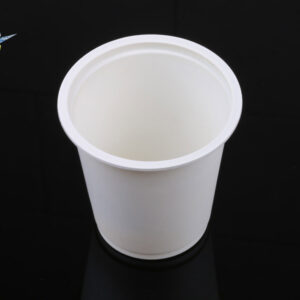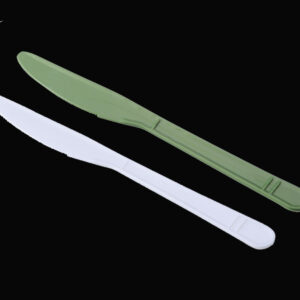Disposable tableware has become a staple in our fast-paced modern lives. Whether hosting a backyard barbecue, enjoying a picnic in the park, or grabbing a quick bite at a food truck, we often rely on conveniently disposable tableware to make our lives easier. However, as our society becomes increasingly aware of environmental issues, it is essential to examine our products’ sustainability and environmental impact. In this blog post, we’re going to look at the Life Cycle Assessment (LCA) of cornstarch-based disposable tableware and highlight the importance of choosing eco-friendly options.

The Need for Sustainable Solutions
The production and disposal of conventional plastic-based disposable tableware contribute to several environmental problems. Traditional plastic tableware is made from petroleum-based materials that require extensive fossil fuel extraction and processing. Moreover, plastic utensils and plates take hundreds of years to degrade and often end up in landfills or oceans, causing pollution and harm to wildlife.
In response to these issues, the development of cornstarch-based disposable tableware has gained popularity. Cornstarch-based products, such as corn, are derived from renewable resources and are often marketed as “biodegradable” or “compostable.” However, to truly understand their environmental impact, we must examine their entire life cycle.
Raw Material Extraction and Processing
The life cycle of cornstarch-based disposable tableware begins with the extraction and processing of corn as the raw material. Corn is a widely grown crop, and through various agricultural practices, it can be sustainably produced. However, it is important to take into account the environmental impacts of large-scale agriculture, such as the use of water, the application of pesticides and soil erosion.
Additionally, the processing of corn into starch and subsequent conversion into tableware requires energy, water, and chemicals. The overall sustainability of cornstarch-based products is directly influenced by the efficiency of these processes.
Manufacturing and Distribution
Once the cornstarch is processed, it is molded into various forms, including utensils, plates, bowls, and cups. The manufacturing process requires energy and resources, such as water and molds. However, compared to traditional plastic tableware production, cornstarch-based alternatives generally have a lower carbon footprint.
After manufacturing, the distribution of cornstarch-based disposable tableware plays a significant role in its environmental impact. Transportation emissions and packaging waste must be considered when evaluating the overall sustainability of these products. Implementing efficient supply chains and eco-friendly packaging materials can help minimize their environmental footprint.
Product Use and Disposal
The use phase of cornstarch-based disposable tableware is similar to conventional options. The utensils and plates are designed to be single-use, providing convenience in various settings. However, it is essential to note that even though these products are often marketed as “compostable” or “biodegradable,” their disposal requires specific conditions to break down effectively.
Composting facilities, industrial composting processes, or specialized anaerobic digestion systems are required to break down cornstarch-based tableware efficiently. If these products end up in regular landfills or oceans, they may not degrade as intended, contributing to pollution and environmental harm similar to conventional plastic tableware.
Sustainability and Environmental Impact
It is important to consider the entire life cycle of corn starch-based disposable tableware, from raw material extraction to disposal, when assessing its sustainability and environmental impact. Life cycle assessments (LCAs) are comprehensive analyses that estimate the environmental impacts of all product life cycle stages.
Several studies have compared the environmental performance of cornstarch-based disposable tableware to conventional plastic options. LCAs have shown that cornstarch-based tableware generally has lower greenhouse gas emissions, energy consumption, and water usage than traditional plastic products. However, the effectiveness of the end-of-life options, such as composting, heavily influences the overall sustainability of cornstarch-based alternatives.
Considerations and Recommendations
While cornstarch-based disposable tableware offers a more sustainable option compared to traditional plastic alternatives, there are several considerations and recommendations to keep in mind:
- Proper Disposal: Ensure that cornstarch-based tableware is disposed of in the correct waste stream. Composting facilities or industrial composting processes are necessary for efficient degradation. Avoid throwing them in regular waste bins or recycling bins.
- Infrastructure Support: The availability of composting facilities varies from region to region. It is crucial to advocate for the development and accessibility of composting infrastructure to support the efficient disposal of cornstarch-based tableware.
- Education and Awareness: Raise awareness among consumers, businesses, and event organizers about the proper disposal and potential environmental benefits of cornstarch-based disposable tableware. Encourage using these products where composting facilities or specialized disposal options are readily available.
- Continuous Improvement: Manufacturers of cornstarch-based tableware should strive to improve production processes, reduce resource consumption, and explore new end-of-life options that maximize sustainability.
Conclusion
The life cycle assessment of cornstarch-based disposable tableware reveals its potential as a more sustainable alternative to traditional plastic options. By understanding the environmental impacts associated with its production, use, and disposal, we can make informed decisions about the tableware we choose.
While cornstarch-based products can significantly reduce greenhouse gas emissions, energy consumption, and water usage, their effectiveness in end-of-life options, such as composting, remains crucial. To fully realize the environmental benefits of cornstarch-based tableware, advocating for proper disposal infrastructure is essential. This includes raising awareness among consumers and businesses about their potential contribution.
We can contribute to a cleaner, greener future by making conscious choices and supporting environmentally friendly alternatives. So, the next time you host a gathering or grab a quick bite, consider the life cycle assessment of cornstarch-based disposable tableware and make a positive impact on the environment.







